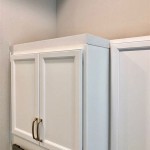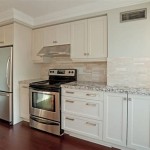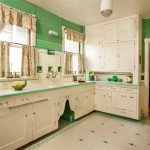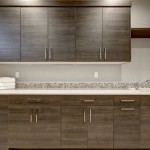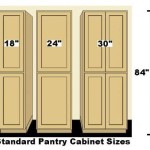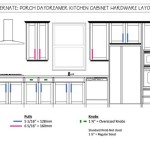How to Wash Kitchen Cabinets Before Painting
Painting kitchen cabinets can dramatically refresh a kitchen's appearance without the expense of a full remodel. However, a successful paint job hinges on proper preparation, and the most crucial step is thoroughly cleaning the cabinets. Grease, grime, and cooking residue can prevent paint from adhering correctly, leading to peeling and an uneven finish. This guide provides a comprehensive approach to washing kitchen cabinets, ensuring a pristine surface ready for a fresh coat of paint.
Essential Cleaning Supplies
Gathering the necessary cleaning supplies beforehand streamlines the process and ensures optimal results. The following items are recommended:
- Degreasing cleaner: A heavy-duty degreaser specifically designed for kitchen use is crucial for cutting through built-up grease and grime.
- Liquid dish soap: Mild dish soap is effective for general cleaning and removing everyday dirt.
- Warm water: Warm water enhances the cleaning power of both degreaser and dish soap.
- Cleaning cloths or sponges: Microfiber cloths are ideal for their absorbency and ability to trap dirt and grime.
- Scrub brush: A scrub brush with soft bristles is useful for tackling stubborn residue in corners and crevices.
- Spray bottles: Spray bottles facilitate even application of cleaning solutions.
- Gloves: Protecting hands with gloves is essential when working with cleaning chemicals.
- Bucket: A bucket provides a convenient container for mixing cleaning solutions.
- Sandpaper (optional): Fine-grit sandpaper can be used to lightly scuff the surface after cleaning, promoting paint adhesion.
Preparing the Cabinets for Washing
Before beginning the washing process, it's important to prepare the cabinets and the surrounding area to prevent accidental damage or mess.
- Empty the cabinets: Remove all dishes, cookware, and food items from the cabinets.
- Protect countertops: Cover countertops with drop cloths or old towels to prevent spills and splashes.
- Remove hardware: Removing knobs, handles, and hinges allows for thorough cleaning and prevents them from being coated with cleaning solutions or paint.
- Ventilate the area: Open windows and doors to ensure adequate ventilation while working with cleaning products.
Degreasing the Cabinets
Grease buildup is a common issue in kitchens, and it's vital to thoroughly degrease cabinets before painting. The following steps outline the degreasing process:
- Dilute the degreaser: Follow the manufacturer's instructions for diluting the degreasing cleaner with warm water.
- Apply the degreaser: Spray the diluted degreaser onto the cabinet surfaces, focusing on areas with visible grease accumulation.
- Allow to sit: Let the degreaser sit on the surfaces for the recommended time, usually a few minutes, to allow it to penetrate the grease.
- Scrub: Use a scrub brush or sponge to scrub the cabinet surfaces, paying attention to corners, crevices, and areas with heavy grease buildup.
- Rinse: Thoroughly rinse the cabinets with clean, warm water to remove all traces of the degreaser.
Washing with Soap and Water
After degreasing, a general wash with soap and water removes any remaining dirt and residue.
- Mix soap and water: Fill a bucket with warm water and add a few drops of mild dish soap.
- Wash the cabinets: Dip a clean cloth or sponge into the soapy water and thoroughly wash all cabinet surfaces.
- Rinse again: Rinse the cabinets again with clean, warm water to remove all traces of soap.
- Dry the cabinets: Dry the cabinets completely with clean, dry cloths. Ensure all moisture is removed before proceeding to the next step.
Final Cleaning and Preparation (Optional)
While the previous steps provide a thorough cleaning, these additional steps can further enhance paint adhesion.
- Sanding (optional): Lightly sanding the cabinet surfaces with fine-grit sandpaper creates a slightly rough texture, improving paint adhesion. After sanding, wipe down the cabinets with a tack cloth to remove any dust.
- Tack Cloth: Use a tack cloth to remove any remaining dust or debris from the cabinets after cleaning and sanding. This ensures a smooth and clean surface for painting.
- Inspecting for damage: Before painting, inspect the cabinets for any damage, such as cracks or holes. Repair any damage before painting to ensure a smooth and professional finish.
By following these detailed cleaning steps, the kitchen cabinets will be impeccably clean and properly prepared, providing an ideal surface for paint adhesion and a long-lasting, professional-looking finish.

How To Clean Cabinets Before Painting Ultimate Guide With Pro Tips Grace In My Space

How To Clean Prep Wood Kitchen Cabinets Before Painting Do Dodson Designs

How To Clean Cabinets Before Painting Ace Hardware

How To Clean Prep Wood Kitchen Cabinets Before Painting Do Dodson Designs

How To Clean Kitchen Cabinets Before Painting Dengarden

7 Amazing Ways To Clean Cabinets Before Painting Jim The Handyman

How To Prep Cabinets Before Painting Painted By Kayla Payne

How To Clean Cabinets Before Painting Ace Hardware

How To Clean Prep Wood Kitchen Cabinets Before Painting Do Dodson Designs

What You Need To Know Before Painting Cabinets The Palette Muse
Related Posts

